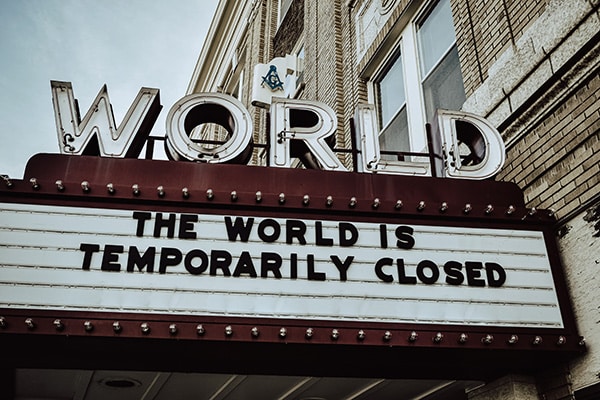Theme
The health, economic, social and political crisis created by the COVID-19 pandemic will also reconfigure international relations and globalisation.
Summary
Similar to the 2008 crisis, the current pandemic and its consequences could precipitate a slowdown in globalisation or even result in a process of deglobalisation. This study seeks to envisage and understand the possible forms of any such reconfiguration of relations, identifying three specific scenarios based on the Elcano Global Presence Index.
In the first scenario, we assume the structural effects on globalisation will be similar to the crisis at the end of the 2000s, both in terms of volumes and nature, allowing the features of globalisation –in all its dimensions, economic, military and soft– to remain intact.
In the second, we assume a deeper impact, comparable to the more significant reductions in each variable during the previous crisis, with a deeper fall in global exchanges, in all areas. Under this scenario, the world will experience an episode of deglobalisation, with a 10% reduction in the soft dimension and a 9% reduction in the economic dimension.
The third and final scenario seeks to account for the specific features compared to the previous one. Here, globalisation will remain intact, particularly in the soft dimension, largely due to the information, technology and science variables.
Analysis
Introduction
The current globalisation process, which dates back to the 1970s, includes phases of growth, contraction and mutation. Many of these correspond to structural changes in the global economic and geopolitical order, including the rise of emerging powers in Asia and the associated shift of the epicentre of global activity from the Atlantic to the Pacific.
The Great Recession at the end of the 2000s and the start of the 2010s has largely resulted in the acceleration and consolidation of these changes, a trend reflected in the Elcano Global Presence Index. The health, economic, political and social crisis currently facing the world will also leave its mark on international relations and the process of globalisation itself.
While it is still too early to predict the impact, we are already seeing some of the consequences of the crisis, such as interruptions in production and consumption (and thus trade). It is also possible to anticipate some of the effects from the dramatic reduction in the international flows of people. Multilateral organisations, the media and research institutes are trying to identify and study many of these short-, medium- and long-term effects.
This paper builds on previous research at the Elcano Royal Institute, reflecting on the consequences of the current crisis for the process of globalisation (Ortega, 2020; Fanjul, 2020). The first section uses the Elcano Global Presence Index to characterise the reconfiguration of globalisation in the crisis at the end of the 2000s. The second section then uses past research to outline the main effects to be expected in the economic, military and soft dimensions of globalisation. Finally, the third details three medium-term scenarios in which the transformational effects of the current crisis are similar, deeper or different to its predecessor.
(1) The interval between the Great Recession and the coronavirus: continued globalisation but slower and softer
The policies of economic liberalisation implemented throughout much of the world in the last three decades of the 20th century resulted in a rapid increase in international economic exchanges. The various waves of economic globalisation have always been accompanied by other forms of internationalisation (military or soft) involving the international movement of people (troop deployments, migrants, tourists, students, sports players in international competitions and international development workers) and ideas (the exchange of information, culture, science, technology and education). While the academic conceptualisation of globalisation has always recognised these other non-economic aspects, analysis of the process of internationalisation has tended to focus on the economic dimension. One of the reasons for this phenomenon is the availability of statistics in this area (Held et al., 1999; Rosenau, 1997; Keohane and Nye, 2000; Conley, 2002; Scholte, 2004; Lee, 2004; Marber, 2005; Caselli, 2008; Figge and Martens, 2014).
This focus on the economic dimension was partly responsible for various analysts predicting globalisation would slow down, end or even enter a period of ‘secular stagnation’ during the financial crisis of 2008 and the Great Recession that followed (Altman, 2009; Summers, 2014; Postelnicu, Dinu & Dabija, 2015). Yet while there was a slowdown –and even a reversion in certain variables and in certain years– in economic internationalisation, particularly for specific trade flows and foreign direct investment, the Elcano Global Presence Index shows that, despite slowing down significantly and mutating towards softer forms of internationalisation, globalisation did not go into reverse (Olivié & Gracia, 2020).
The Elcano Global Presence Index (Figure 1) was developed for the two-fold objective of providing a tool for exploring the international projection of countries, calculated in terms of both volumes and nature, and of observing global trends in internationalisation processes. Given the large number of countries for which it is currently calculated (120) and its representativeness in terms of the global population and GDP, it is also a useful tool for studying the process of globalisation itself (Olivié et al., 2017, 2018).

Globalisation since 1990 can be divided into three phases: (a) an initial phase of deglobalisation between 1990 and 1995, coinciding with the geopolitical reconfiguration of Europe, when the aggregate global presence fell by an annual average of -0.7%; (b) a second period of sustained globalisation between 1995 and 2011, with a cumulative increase of 43%, equivalent to an annual average of 2.7%; and (c) the current phase, with moderate increases and decreases and annual averages of just under 1% (Figure 2).
It is important to stress that the Elcano Global Presence Index captures structural trends, meaning transient financial turbulence or political changes are seldom reflected in its results. There is also a lag of around two years before changes in the dimensions and variables are reflected by the index. The effects of the 2008-09 crisis are not reflected by the index until 2011 and the effects of the COVID-19 pandemic are not expected to register in the values of the index until 2021 or 2022. With these caveats in mind, the value of the index for the last year for which data is available (2018) shows an unprecedented rise in globalisation since the start of the crisis at the end of the 2000s, with the aggregate value of 12,646 for the 120 countries currently included in the calculation, compared to 12,199 for the previous year.
These figures suggest that the world has not yet experienced a process of deglobalisation. While this trend may have slowed down since the start of the decade, except for two falls (-0.7% in 2014 and -1.4% in 2015), the process has not contracted and was recovering prior to the current crisis.
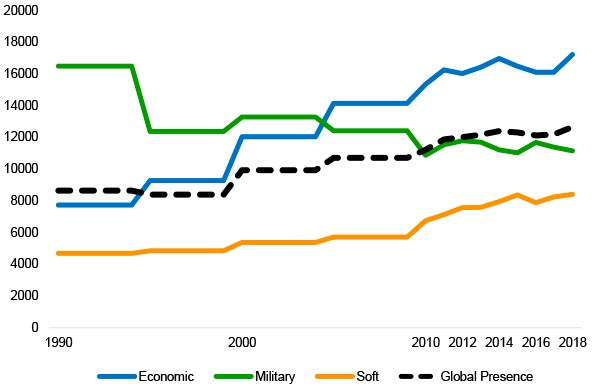
The different variables and dimensions (economic, military and soft) have also contributed in different ways to the speed of globalisation in recent years. Between 1990 and 2005, the main vector of globalisation was the economic dimension, whose rate of growth was between 3.5% and 6%. The soft dimension made a positive albeit modest contribution to the process during this period, with growth of 0.7%-2.2%. Finally, the military dimension shows a certain deglobalisation, with negative rates for most of the period (Figure 3).
However, these trends change significantly in the 2000s, when the soft dimension begins to lead the process of globalisation, with average annual growth of 3.6%-5.0%. At the same time, the economic dimension becomes much less dynamic, with low and even negative interannual growth (2016 and 2017), together with a slight recovery in the military dimension, which grew in 2015 and 2016.
In short, during this period of slow globalisation, the nature of the process also changed, with the soft dimension replacing the economic dimension as the main vector. Similarly, the structural contraction of the military dimension during the first two decades was replaced by a modest but sustained recovery.
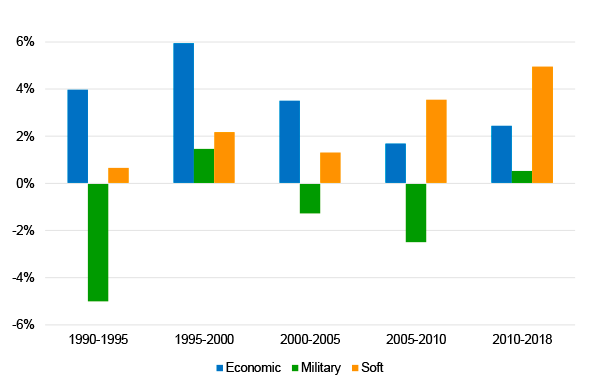
(2) The effects of the coronavirus on global exchanges
There are a number of points to consider before reflecting on the potential impact of the current health crisis and the subsequent outlook for the process of globalisation, both as a whole and in its various dimensions and indicators.
First, there is the dimension of time. We must distinguish between analyses of the short-term effect of the health emergency itself, together with the measures to contain it, and the medium- and long-term effects. In macroeconomic terms, the debate, which is still in its early stages, is focused on the shock itself, to supply and/or demand and its effects (Camaduro & Papadia, 2020; Carlsson-Szlezak, Reeves & Swartz, 2020; Fornaro & Wolf, 2020), alongside the political responses required based on the different diagnostics (McKibbin & Fernando, 2020; OECD, 2020b). However, the consequences of the shock and the scale of the response will also depend on how long the health emergency and the confinement measures persist. There is no doubt that the severity of the situation requires a reactivation of major State policy intervention (Bénassy-Quéré et al., 2020; Krugman, 2020; Saez & Zucman, 2020; de Grauwe, 2020; Gali, 2020; Wolf, 2020).
Analysts agree that the crisis we are facing will have a major economic impact on all dimensions of international exchange (OECD, 2020b, 2020a) and that both its duration and the different responses will affect the rhythm and nature of globalisation in different ways (IMF, 2020).
Secondly, despite numerous comparisons with the economic situation during the Second World War and the years that followed, there are significant differences, such as the absence of the need for the large-scale reconstruction of major infrastructure, which would have countered the supply shock. Above all, however, we are living in different times (Hernández, 2020). We are in a context in which integration processes are going into reverse and national identities are strengthening, while the spread of the health crisis and its effects are global in nature. Even before the outbreak of the pandemic, we were witnessing a trade war between the US and China, largely driven by a technology race, now intensified by the response to the health crisis and the scramble to find a vaccine (Campbell & Doshi, 2020). However, we do not know how the pandemic will impact this geopolitical rivalry, particularly in terms of the effects on China and its growth, internal cohesion and international image (Esteban, 2020). Similarly, at the time of writing, the health emergency is still in its early stages in the US.
The crisis has hit at a time in which part of the international community is questioning the pillars of the world order put in place after the Second World War, especially multilateral governance and the meaning and even existence of the EU. All this means that a health crisis that is undeniably global in nature is occurring in a context in which national identities are being reasserted.
(2.1) Economic dimension
There is unanimous consensus on the negative economic impact of the current crisis on the global economy, both in the short and medium term. In the energy and commodities markets, the crisis is framed by the drop in oil prices as a result of the conflict between Russia and Saudi Arabia, which has dragged down the prices of other primary goods (Escribano, 2020).
In terms of trade and investment, the pandemic has struck at a moment at which production and investment are highly transnational in nature, with fragmented manufacturing processes distributed across global production chains (Molina, 2020).
The current situation is laying bare the vulnerability of current models of production, characterised by their flexibility (short production lines, the minimisation of stock and just-in-time supply chains) compared with supplier countries (Treceño, 2020; Haren & Simchi-Levi, 2020). As Fanjul (2020) notes, the crisis has highlighted the risk of geographic dependence on China, which could either result in strategies to diversify the location of suppliers, without negatively impacting aggregate trade, or trigger a wave of relocalisation, with the associated drop in trade volumes.
In terms of service exports, while they have been increasing in recent years, most notably in line with the transnationalisation of production, a significant fall in service flows is expected as a result of the impact on the global tourism sector. Economies like Spain, with a large service sector and a heavy emphasis on tourism, will see a significant impact from the pandemic as a result of the fall in visitors.
The impact of the external shock to foreign direct investment (the fifth indicator in the economic dimension of the Elcano Global Presence Index) will depend on the reconfiguration of transnational production and the impact on international financial markets in the medium term (Álvarez-Pickman, 2020).
(2.2) Military dimension
We may not immediately expect to see a direct link between the coronavirus and the military dimension of the Elcano Global Presence Index. While the armed forces have played a significant role in managing the health crisis in practically all countries, at present their role is limited to national territories. Nonetheless, we cannot rule out future international missions to respond to specific health emergencies in specific countries, especially developing ones.
(2.3) Soft dimension
As explained in the first section, the soft dimension has been the main vector of globalisation since the crisis at the end of the 2000s. However, in contrast to this crisis, this time round there are reasons to expect a significant but uneven impact on a number of areas. The main variables that will be affected are those that imply the movement of people, such as tourism, migration, education and sports (Molina, 2020). In this respect, we have already seen the cancellation of international sporting events like the Olympic Games.
Nonetheless, other soft variables could be strengthened by the coronavirus crisis. In terms of information, there is nothing surprising about the current increase in international news. Similarly, confinement and the rise in people working from home mean improvements to the physical infrastructure of the Internet. The variable of science may also behave in a similar way, given the increase in scientific research (vaccines and treatments, pandemics and climate change) and the important role of the social sciences (analysis of the impact and exploring the economic, political and social dimensions of responses).
There are also other indicators in the soft dimension where different factors with opposite effects mean the overall impact of the crisis could be positive or negative. The indicator for the variable technology, for example, reflects foreign patents, which is linked to trade and may thus fall, although it is equally possible that there could be an increase in this variable, since, similar to the variable science, there may be a rise in patents due to the need for new technology, which could in turn drive investment in research and development.
The situation for the culture variable, measured by exchanges of audio-visual services, is similar: the retreat of economies inside national boundaries and falling global trade over the coming years could exert downward pressure on such exchanges, although digital exchanges could escape from this dynamic, especially if we take into account the increased consumption of films, television series and music during confinement.
Finally, when it comes to development cooperation, certain governments may choose to increase development aid to help preserve global public goods, particularly in the area of health, although we could also see cuts to spending in a context of strengthening national identities and the reduction of forums for multilateral cooperation (Olivié, 2020).
(3) How will this affect the globalisation process?
One way to measure the response is by calibrating its impact on the aggregate of the Elcano Global Presence Index (with all the necessary caveats and reservations). This can be done by examining the transformational effect during the previous crisis in 2008 (section 1 of this paper) and forecasting the impact of the current pandemic on the different variables and dimensions of the index (section 2).
(3.1) Scenario A: a crisis like 2008
Generally speaking, structural changes have a two-year lag before they are reflected in the Elcano Global Presence Index. The 2018 index, which was published in 2019, includes the data for the 16 variables available as of 31 December 2018. In general, the data refer to 2017 or in some cases 2016. This means that the structural effects of the crisis that began with the collapse of Lehman Brothers in autumn 2008 are first reflected by our index in 2010 and extend into the second half of the decade.
If the current health emergency and its economic, political and social consequences are on a similar scale to the crisis last decade, we would expect the change in the aggregate of the Elcano Global Presence Index to be similar to the period 2010-15, for all the variables and dimensions (Figure 4).
(3.2) Scenario B: a crisis worse than 2008
Some analysts argue that the economic, political and social consequences will be more devastating and deeper than those of the 2008 crisis. In such a scenario, the figures for the various components of the index would, perhaps from 2022, register the worst possible decline for each of the indicators during the period 2010-18 (Figure 4).
(3.3) Scenario C: a different crisis to 2008
Finally, the particular features of this crisis and the differences with respect to 2008 may mean that variables behave differently, as mentioned in the previous section.
Energy is a good example: energy prices are at historic lows and policies linked to climate change are expected to continue, especially the process of replacing fossil fuels. The behaviour of this variable is expected to be similar to previous years (Escribano & Lázaro, 2020), which will translate into similar behaviour for the primary goods variable. If this is the case, the average annual variation for the coming years could be around -2.6%, which is the average value for the period 2015-18 (Figure 5).
Also in the economic dimension, the outlook for manufacturing is similar, since it has already shown a cooling down of international trade. In the military dimension, the troops and military equipment variables should also behave in a similar manner, since, at least in principle, there should not be a significant reaction to the current crisis. In terms of the soft dimension, the culture variable is expected to follow a similar course, since it could be significantly affected by a fall in international trade or increased consumption of services linked to culture. Similarly, the evolution of the development cooperation variable will depend on the tension between increased pressure to reduce public spending and the demand for increased protection of global public goods.
In terms of services, the tourism industry could see a significant impact, perhaps comparable to the worst years of 2010-18 (and thus of a similar magnitude to scenario B), alongside other variables that involve the flow of people (migration, tourism, sport and education).
There is also a third group of variables that could behave similarly to the aftermath of the Great Recession (and thus similar to scenario A) in the short term. Investment is a good example, given the potential for the relocalisation of production and the sensitivity of this variable to the behaviour of international financial markets. In the soft dimension, there are a number of variables that could follow this pattern: information, due to increased consumption and the foreseeable increase in installed capacity, and technology and science, in which major powers that did not suffer the crisis like many European economies have invested.Figure 4. Three scenarios for globalisation after COVID-19 (%)
| Scenario A Crisis similar to 2008 Average rate (2010-15) | Scenario B Crisis worse than 2008 Larger reduction (2010-18) | Scenario C Different crisis to 2008 Average rates Figure 5 | |
|---|---|---|---|
| Energy | 7.2 | -7.3 | -2.6 |
| Primary goods | -0.5 | -36.7 | -10.5 |
| Manufacturing | 3.3 | -3.3 | -0.5 |
| Services | 1.3 | -1.4 | -1.4 |
| Investment | 1.0 | -12.4 | 1.0 |
| Troops | -3.4 | -8.3 | 0.5 |
| Military equipment | 4.0 | -1.9 | -0.2 |
| Migration | -1.0 | -1.1 | -1.1 |
| Tourism | 3.5 | 1.9 | 1.9 |
| Sport | -1.3 | -1.7 | -1.7 |
| Culture | 11.2 | -11.7 | 1.2 |
| Information | 16.5 | -3.1 | 16.5 |
| Technology | 3.1 | -27.4 | 3.1 |
| Science | 3.2 | -16.5 | 3.2 |
| Education | 4.3 | -1.2 | -1.2 |
| Development cooperation | 4.7 | -12.2 | 1.3 |
| Arguments + | Arguments – | Estimate (%) | |
|---|---|---|---|
| Energy | Oil dependency | Price war, climate change policies | -2.6 |
| Primary goods | Link to oil prices, financial markets | -10.5 | |
| Manufacturing | Transnational nature of current global value chains | Relocalisation, production shutdowns | -0.5 |
| Services | Transnational nature of current global value chains | Relocalisation, production shutdowns, tourism | -1.4 |
| Investment | Transnational nature of current value chains, financial mergers and acquisitions | Relocalisation, financial crisis | 1.0 |
| Troops | Health missions | National withdrawal | 0.5 |
| Military equipment | -0.2 | ||
| Migration | Migration crises | National withdrawal | -1.1 |
| Tourism | National withdrawal, health crisis | 1.9 | |
| Sport | Cancellation of events and competitions | -1.7 | |
| Culture | Digital consumption | Reduction in multiculturalism | 1.2 |
| Information | Increase in news and Internet infrastructure | 16.5 | |
| Technology | Increase in technology development | Fall in trade | 3.1 |
| Science | Increase in publications | 3.2 | |
| Education | Reduction in movement | -1.2 | |
| Development cooperation | Global health | National withdrawal | 1.3 |
Just one of the three scenarios (scenario B) results in effective deglobalisation, which would affect all the dimensions, especially the economy, with the total economic presence of the 120 countries for which the index is calculated falling by 630 points (9%) with respect to the most recent value for 2018. The reduction in the soft dimension would be approximately half (10%) and the military dimension would fall by 100 points (Figures 6 and 7). The net result would be a fall of 1,065 points (8.5%) in the aggregate global presence of the 120 countries included in the calculation of the index with respect to the 2018 figure, resulting in a return to the post-crisis levels of globalisation.
However, if the transformational effects are similar to the previous crisis (scenario A), we could expect continuity in the process of globalisation, with cumulative increases, particularly in the soft dimension (over 200 points or 6%) and, to a lesser extent, the economic dimension (just under 150 points or slightly over 2%). The combined effect would be an increase of 391 points (3.1%) in the aggregate global presence, just 0.7 of a percentage point less than the change between 2017 and 2018.
Finally, the scenario based on different transformational effects from the previous crisis, would see a near standstill in globalisation, with the aggregate global presence increasing by just 88 points (0.7%). This would be the result of a more dynamic soft dimension, whose 120-point increase (3.6%) would be offset by a slight fall in the economic dimension (-0.5%), with the military dimension practically unchanged.
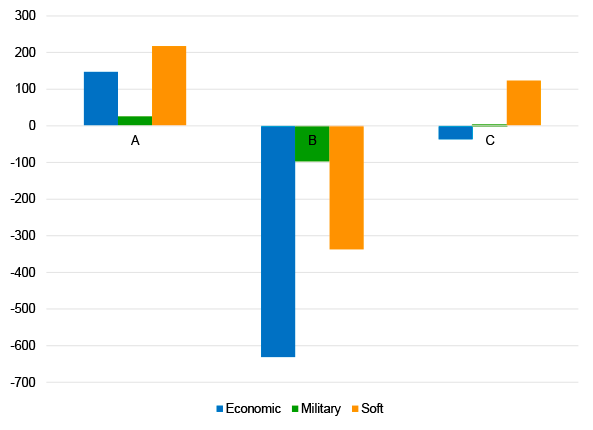
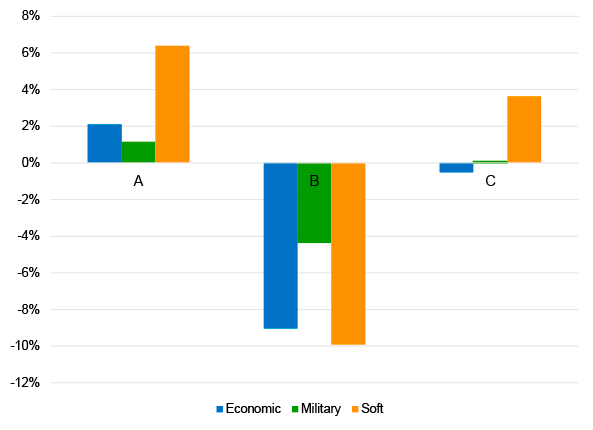
Conclusions
Similar to the crisis at the end of the 2000s, the current crisis will have an impact on international relations. We can expect to see an acceleration in the structural changes that we have already been seeing in the process of globalisation.
Under all three scenarios identified, the soft dimension will lead globalisation, as was the case in the aftermath of the 2008 crisis, despite the potential for restrictions on the movement of people (which will affect the variables of education, tourism and migration). Above all, this can be explained by the expected dynamism of the variables information, technology and science, sectors that are set to grow, consolidating the technology gap between countries and regions, as well as how this increasingly shapes the roles of different countries and blocks (eg, China, the US and Europe) on the international stage.
Bibliography
Altman, Roger C. (2009), ‘Globalization in retreat: further geopolitical consequences of the financial crisis’, Foreign Affairs, vol. 88, nr 4, p. 2-7.
Álvarez-Pickman, Alfredo (2020), ‘El “shock” de la oferta y la demanda’, Cinco Días, 25/03/2020.
Bénassy-Quéré, Agnès, Ramon Marimon, Jean Pisani-Ferry, Lucrezia Reichlin, Dirk Schoenmaker & Beatrice Weder di Mauro (2020), ‘COVID-19: Europe needs a catastrophe relief plan’, in Richard Baldwin & Beatrice Weder di Mauro (Eds.), Mitigating the COVID Economic Crisis: Act Fast and Do Whatever It Takes, Vox CEPR.
Camaduro, Leonardo, & Francesco Papadia (2020), ‘Three macroeconomic issues and Covid-19’, Blog post.
Campbell, Kurt M., & Rush Doshi (2020), ‘The coronavirus could reshape global order. China is maneuvering for international leadership as the United States falters’, Foreign Affairs.
Carlsson-Szlezak, Philipp, Martin Reeves & Paul Swartz (2020), ‘What coronavirus could mean for the global economy’, Harvard Business Review.
Caselli, Marco (2008), ‘Measuring… what? Notes on some globalization indices’, Globalizations, vol. 5, nr 3, p. 383-404.
Conley, Tom (2002), ‘The state of globalisation and the globalisation of the state’, Australian Journal of International Affairs, vol. 56, nr 3, p. 447-471.
de Grauwe, Paul (2020), ‘The ECB must finance COVID-19 deficits’, Project Syndicate, 18/III/2020.
Escribano, Gonzalo (2020), ‘El coronavirus pone fin al idilio petrolero entre Rusia y Arabia Saudí con una guerra de precios’, Elcano Blog, Elcano Royal Institute, 10/III/2020.
Escribano, Gonzalo, & Lara Lázaro (2020), ‘Energía, clima y coronavirus’, ARI, nr 131/2020, Elcano Royal Institute.
Esteban, Mario (2020), ‘La crisis del coronavirus y el estatus internacional de China: cuando la geopolítica y la política doméstica no van de la mano’, ARI, nr 6/2020, Elcano Royal Institute.
Fanjul, Enrique (2020), ‘El coronavirus, ¿nuevo impulso a la desglobalización?’, Blog Elcano, Elcano Royal Institute, 12/III/2020.
Figge, Lukas, & Pim Martens (2014), ‘Globalisation continues: the Maastricht Globalisation Index revisited and updated’, Globalizations, vol. 11, nr 6, p. 875-893.
Fornaro, Luca, & Martin Wolf (2020), ‘Covid-19 coronavirus and macroeconomic policy: some analytical notes’.
Gali, Jordi (2020), ‘Helicopter money: the time is now’, en Richard Baldwin & Beatrice Weder di Mauro (Eds.), Mitigating the COVID Economic Crisis: Act Fast and Do Whatever It Takes, Vox CEPR.
Haren, Pierre, & David Simchi-Levi (2020), ‘How coronavirus could impact the global supply chain by mid-March’, Harvard Business Review.
Held, David, Anthony McGrew, David Goldblatt & Jonathan Perraton (1999), ‘Globalization’, Global Governance, nr 5, p. 483-496.
Hernández, Esteban (2020), ‘Calviño, el plan Marshall de Sánchez y lo que se está cociendo en EEUU’, Postpolítica (blog), El Confidencial, 23/III/2020.
IMF (2020), ‘Policy responses to COVID-19’, Policy tracker, International Monetary Fund.
Keohane, Robert O., & Joseph S. Nye (2000), ‘Globalization: what’s new? What’s not? (And so what?)’, Foreign Policy, nr 118 (spring), p. 104-119.
Krugman, Paul (2020), ‘The case for permanent stimulus’, in Richard Baldwin & Beatrice Weder di Mauro (Eds.), COVID-19: Europe Needs a Catastrophe Relief Plan, Vox CEPR.
Lee, Kelley (2004), ‘20 best resources on globalization’, Health Policy and Planning, vol. 20, nr 2, p. 137-139.
Marber, Peter (2005), ‘Globalization and its contents’, World Policy Journal, vol. 21, nr 4, p. 29-37.
McKibbin, Warwick, & Roshen Fernando (2020), ‘The global macroeconomic impacts of COVID-19: seven scenarios’, CAMA Working Paper.
Molina, Ignacio (Ed.) (2020), ‘España en el mundo en 2020: perspectivas y desafíos para el año del coronavirus’, Elcano Policy Paper, nr 1/2020, Elcano Royal Institute.
OECD (2020a), ‘Coronavirus: the world economy at risk’, OECD Interim Economic Assessment.
OECD (2020b), ‘Evaluating the initial impact of COVID-19 containment measures on economic activity’, Tackling Coronavirus (COVID-19) Contributing to a Global Effort.
Olivié, Iliana (2020), ‘¿Cómo será la ayuda al desarrollo después de la crisis del coronavirus?’, Blog Elcano, Elcano Royal Institute, 30/III/2020.
Olivié, Iliana, & Manuel Gracia (2020), ‘Is this the end of globalization (as we know it)?’, Globalizations, to be published.
Olivié, Iliana, Manuel Gracia, Michaela Saisana, Marcos Domínguez-Torreiro & Marcos Álvarez-Díaz (2017), ‘Informe Elcano de Presencia Global 2017’.
Olivié, Iliana, Manuel Gracia, Elizabeth Sidiropoulos & Steven Gruzd (2018), ‘Informe Elcano de Presencia Global 2018’.
Ortega, Andrés (2020), ‘The deglobalisation virus’, Blog Elcano, Elcano Royal Institute, 17/III/2020.
Postelnicu, Catalin, Vasile Dinu & Dan-Cristian Dabija (2015), ‘Economic deglobalization–From hypothesis to reality’, Ekonomie, vol. XVIII, nr 2, p. 4-14.
Rosenau, James N. (1997), ‘The complexities and contradictions of globalization’, Current History, vol. 96, nr 613, p. 360-364.
Saez, Emmanuel, & Gabriel Zucman (2020), ‘Keeping business alive: the government as buyer of last resort’, mimeo.
Scholte, Jan Aart (2004), ‘Globalization studies: past and future: a dialogue of diversity’, Globalizations, vol. 1, nr 1, p. 102-110.
Summers, Lawrence (2014), ‘Reflections on the “new secular stagnation hypothesis”,’ in Coen Teulings & Richard Baldwin (Eds.), Secular Stagnation: Facts, Causes and Cures, nr 27-38, CEPR.
Treceño, Beatriz (2020), ‘Las empresas se preparan para un parón en los suministros’, Expansión, 26/02/2020.
Wolf, Martin (2020), ‘The virus is an economic emergency too’, Financial Times, 17/III/2020.
The world is temporarily closed. Photo: Edwin Hooper (@edwinhooper)
